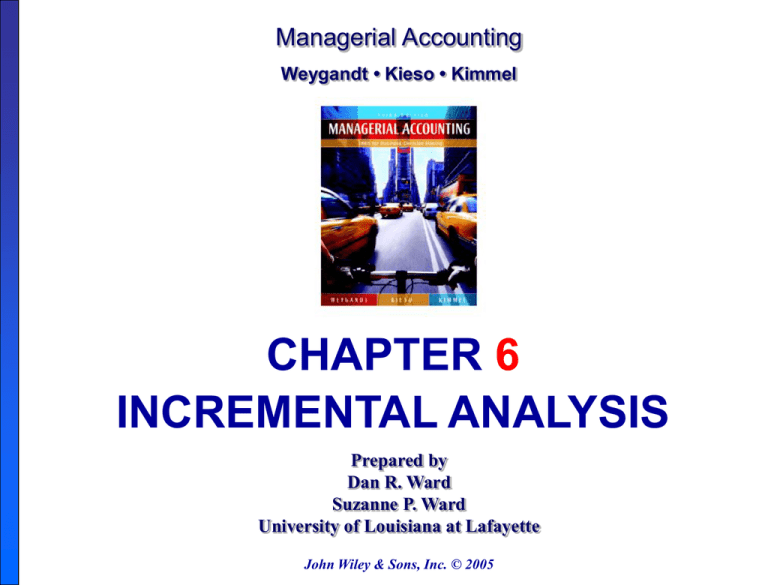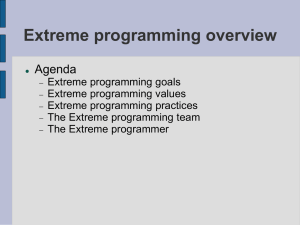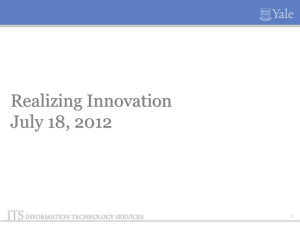
Managerial Accounting
Weygandt • Kieso • Kimmel
CHAPTER 6
INCREMENTAL ANALYSIS
Prepared by
Dan R. Ward
Suzanne P. Ward
University of Louisiana at Lafayette
John Wiley & Sons, Inc. © 2005
CHAPTER 6
INCREMENTAL ANALYSIS
Study Objectives
Identify the steps in management’s decisionmaking process.
Describe the concept of incremental analysis.
Identify the relevant costs in accepting an order
at a special price.
Identify the relevant costs in a make-or-buy
decision.
Identify the relevant costs in determining
whether to sell or process further.
Study Objectives:
Continued
Identify the relevant costs to
be considered in retaining
or replacing equipment.
Identify the relevant costs in
deciding whether to
eliminate an unprofitable
segment.
Determine sales mix when a
company has limited
resources.
MANAGEMENT’S
DECISION-MAKING PROCESS
Study Objective 1
Does not always follow a set pattern or process
Decisions vary in scope
Decisions vary in urgency and importance
However some steps can be identified:
MANAGEMENT’S
DECISION MAKING PROCESS
Considers both financial
and nonfinancial
information
Financial information
• Revenues and costs
• Overall profitability
Nonfinancial information
• Effect of decision on
employee turnover
• Environment
• Overall image of
company
MANAGEMENT’S DECISION-MAKING
Incremental Analysis Approach
Study Objective 2
Decisions involve a choice among alternative actions
Financial data relevant to a decision are the data that
vary in the future among alternatives
Both costs and revenues may vary or
Only revenues may vary or
Only costs may vary
Incremental Analysis: Process to identify financial
data that change under alternative actions
Identifies probable effects of decisions on future
earnings
MANAGEMENT’S DECISION MAKING
How Incremental Analysis Works
Example
Revenues
Costs
Net income
Alternative
Alternative
A
B
$125,000
$110,000
100,000
80,000
$ 25,000
$ 30,000
Net Income
Increase (Decrease)
$(15,000)
20,000
$ 5,000
Alternative B is being compared to Alternative A
Incremental revenue is $15,000 less under Alternative B
Incremental cost savings of $20,000 is realized
Alternative B produces $5,000 more net income
MANAGEMENT’S DECISION MAKING
How Incremental Analysis Works
Uses three important cost concepts
Let’s Review
Incremental analysis is the process of
identifying the financial data that:
a. Do not change under alternative courses of
action
b. Change under alternative courses of action
c. Are mixed under alternative courses of action
d. None of the above
Let’s Review
Incremental analysis is the process of
identifying the financial data that:
a. Do not change under alternative courses of
action
b. Change under alternative courses of action
c. Are mixed under alternative courses of action
d. None of the above
MANAGEMENT’S DECISION MAKING
Types of Incremental Analysis
Accept an order at a special
price
Make or buy component parts
or finished products
Sell products or process
further
Retain or replace equipment
Eliminate an unprofitable
business segment
INCREMENTAL ANALYSIS
Accept an Order at a Special Price
Study Objective 3
Obtain additional business
by making price
concessions
Assumes sales of the
products in other markets
would not be affected by
special order
Assumes company is not
operating at full capacity
INCREMENTAL ANALYSIS
Accept an Order at a Special Price
Example
Customer offers to buy a special order of 2,000
blenders at $11 per unit from Sunbelt.
No effect on normal sales; sufficient plant capacity
Operating at 80 percent capacity = 100,000 units
Current fixed manufacturing costs = $400,000 or $4 per unit
Variable manufacturing cost = $8 per unit
Normal selling prince = $20 per unit
Based strictly on total cost of $12 per unit ($8 + $4),
reject offer as cost exceeds selling price of $11
INCREMENTAL ANALYSIS
Accept an Order at a Special Price
Example (Continued)
No change in fixed costs since within existing capacity –
thus fixed costs are not relevant
Only total variable costs change – thus they are relevant
Revenues
Costs
Net income
Reject Order
$ -0-0$ -0-
Accept Order
$22,000
16,000
$ 6,000
Net Income
Increase (Decrease)
$22,000
(16,000)
$ 6,000
Revenue increases $22,000; variable costs increase $16,000;
Thus, net income increases $6,000
Decision: Accept the offer – Income will increase by $6,000.
INCREMENTAL ANALYSIS
Make or Buy
Study Objective 4
Outsourcing: The decision to buy parts or services
rather than making them
Example:
Baron Co. incurs the following costs to make 25,000 switches:
Switches can be purchased for $8 per switch ($200,000)
Eliminates all variable costs and $10,000 of fixed costs;
however, $50,000 of fixed costs remain
INCREMENTAL ANALYSIS
Make or Buy
Example (Continued)
Direct materials
Direct labor
Variable manufacturing costs
Fixed manufacturing costs
Purchase price
Total annual cost
Make
$ 50,000
75,000
40,000
60,000
-0$225,000
Buy
$ -0-0-050,000
200,000
$250,000
Net Income
Increase (Decrease)
$ 50,000
75,000
40,000
10,000
(200,000)
$ (25,000)
Based on analysis of costs under both alternatives:
Purchasing adds $25,000 to cost of switches
Decision: Continue to make switches.
INCREMENTAL ANALYSIS
Opportunity Costs
The potential benefit
that may be obtained
from following an
alternative course of
action
INCREMENTAL ANALYSIS
Opportunity Costs
Example – Baron Company Continued
Assume that buying the switches allows Baron to use the
released capacity to generate $28,000 additional income.
Thus, the $28,000 lost income is an additional cost of making
the switches
Total annual cost
Opportunity cost
Total cost
Make
Buy
$225,000 $250,000
28,000
-0$253,000 $250,000
Net Income
Increase (Decrease)
$(25,000)
28,000
$ 3,000
Decision: Based on the analysis,
Baron should buy the switches
as the company will be $3,000 better off.
INCREMENTAL ANALYSIS
Sell or Process Further
Study Objective 5
Manufacturers may have to decide, at a given point in
production, whether to sell now or to process further
and sell at a higher price later.
Decision Rule:
Process further as long as
the incremental revenue from
such processing exceeds the
incremental processing costs
INCREMENTAL ANALYSIS
Sell or Process Further
Single-Product Case
Cost to manufacture one unfinished table:
Direct materials
Direct labor
Variable manufacturing overhead
Fixed manufacturing overhead
Manufacturing cost per unit
$15
10
6
4
$35
Selling price of unfinished unit is $50
Unused capacity used to finish the tables to sell for
$60 per table.
Relevant unit costs of finishing tables:
Direct materials increase $2
Direct labor increase $4
Variable manufacturing overhead costs increase by
$2.40 (60 percent of direct labor increase)
Fixed manufacturing costs will not increase
INCREMENTAL ANALYSIS
Sell or Process Further
Single-Product Case (Continued)
Sales per unit
Cost per unit
Direct materials
Direct labor
Variable manufacturing overhead
Fixed manufacturing overhead
Total
Sell
$50.00
Process
Further
$60.00
Net Income
Increase (Decrease)
$10.00
15.00
10.00
6.00
4.00
$35.00
17.00
14.00
8.40
4.00
$43.40
(2.00)
(4.00)
(2.40)
- 0 $(8.40)
Net income per unit
$15.00
$16.60
$1.60
Decision: Process further.
Incremental revenue ($10) exceeds incremental processing
costs ($8.40); income increases $1.60 per unit
INCREMENTAL ANALYSIS
Sell or Process Further
Multiple-Product Case
Especially appropriate when multiple products are produced
simultaneously
Many end-products are produced from a single raw material
and a common production process
Joint products - multiple end products
Petroleum – gasoline, lubricating oil, kerosene
Meat Packing – meat, hides, bones
INCREMENTAL ANALYSIS
Sell or Process Further
Multiple-Product Case
Joint costs
all costs incurred prior to split-off point
allocate to individual products based on relative sales value
Sunk costs
already incurred and cannot be changed
irrelevant for sell or process
further decisions
Joint costs are sunk costs for sell or process further decisions.
INCREMENTAL ANALYSIS
Sell or Process Further
Multiple-Product Case
Example - Marais Creamery decision:
Sell cream and skim milk
or
Process them further before selling
INCREMENTAL ANALYSIS
Sell or Process Further
Multiple-Product Case – Example (Continued)
Sell cream or process further into cottage cheese?
Joint cost allocated to cream
Processing cream into cottage cheese
Expected revenue per day:
Cream $19,000
Cottage cheese
Sales per day
Cost per day
Processing cream into
cottage cheese
Sell
$19,000
Process
Further
$27,000
-0$19,000
10,000
$17,000
$ 9,000
$10,000
$27,000
Net Income
Increase (Decrease)
$ 8,000
(10,000)
$ (2,000)
Decision: Do not process the cream further.
Incremental revenue ($8,000) is less than incremental costs ($10,000);
income decreases $2,000.
INCREMENTAL ANALYSIS
Sell or Process Further
Multiple-Product Case – Example (Continued)
Sell skim milk or process further into condensed milk?
Joint cost allocated to skim milk
$ 5,000
Processing skim milk into condensed milk
$ 8,000
Expected revenue per day:
Skim milk $11,000
Condensed milk $26,000
Sales per day
Cost per day
Processing skim milk into
condensed milk
Sell
$11,000
Process
Further
$26,000
-0$11,000
8,000
$18,000
Net Income
Increase (Decrease)
$ 15,000
( 8,000)
$ 7,000
Decision: Process the skim milk further.
Incremental revenue ($15,000) exceeds incremental costs ($8,000);
income increases $7,000.
INCREMENTAL ANALYSIS
Retain or Replace Equipment
Study Objective 6
Example
Assessment of replacement of a factory machine:
Book value
Cost
Remaining useful life
Scrap value
Old Machine
$40,000
four years
-0-
Variable costs:
Decrease from $160,000
to $125,000 annually
New Machine
$120,000
four years
-0-
INCREMENTAL ANALYSIS
Retain or Replace Equipment
Example (Continued)
Variable manufacturing costs
New machine cost
Total
a(4
Retain
$640,000a
$640,000
years x $160,000)
Replace
$500,000b
120,000
$620,000 $ 20,000
b(4
Net Income
Increase (Decrease)
$140,000
(120,000)
years x $125,000)
Decision: replace equipment.
Lower variable manufacturing costs more than
offset cost of new equipment.
The book value of the old machine does not affect
the decision.
INCREMENTAL ANALYSIS
Eliminate an Unprofitable Segment
Study Objective 7
Key: Focus on relevant costs
Consider effect on related product lines
Fixed costs allocated to the unprofitable segment
must be absorbed by the other segments
Net income may decrease when an unprofitable
segment is eliminated
Decision Rule:
Retain the segment unless fixed costs eliminated
exceed the contribution margin lost
INCREMENTAL ANALYSIS
Eliminate an Unprofitable Segment
Study Objective 7
Example – Martina Company
Manufactures three models of tennis racquets:
Profitable lines: Pro and Master
Unprofitable line: Champ
Condensed Income Statement data:
Sales
Variable expenses
Contribution margin
Fixed expenses
Net income
Pro
$800,000
520,000
280,000
80,000
$200,000
Master
$300,000
210,000
90,000
50,000
$ 40,000
Champ
$100,000
90,000
10,000
30,000
$(20,000)
Should Champ be eliminated?
Total
$1,200,000
820,000
380,000
160,000
$ 220,000
INCREMENTAL ANALYSIS
Eliminate an Unprofitable Segment
Example (Continued)
If Champ is eliminated, allocate its $30,000 fixed costs:
2/3 to Pro and 1/3 to Master
Revised Income Statement data:
ELIMINATE CHAMP?
Sales
Variable expenses
Contribution margin
Fixed expenses
Net income
Pro
$800,000
520,000
280,000
100,000
$180,000
Master
Total
$300,000 $1,100,000
210,000
730,000
90,000
370,000
60,000
160,000
$ 30,000 $ 210,000
Total income has decreased by $10,000 ($220,000 - $210,000)
INCREMENTAL ANALYSIS
Eliminate an Unprofitable Segment
Example (Continued)
Incremental analysis of Champ provides the same results
ELIMINATE CHAMP?
Sales
Variable expenses
Contribution margin
Fixed expenses
Net income
Continue
$100,000
90,000
10,000
30,000
$(20,000)
Eliminate
$ -0-0-030,000
$ 30,000)
Net Income
Increase (Decrease)
$(100,000)
90,000
(10,000)
-0$ (10,000)
Decrease in net income is due to Champ’s contribution margin ($10,000)
that will not be realized if the segment is discontinued
Decision: Do not eliminate Champ.
INCREMENTAL ANALYSIS
Allocate Limited Resources
Study Objective 8
Resources are always limited
floor space for a retail firm
raw material, direct labor hours, or
machine capacity for a manufacturing
firm
Management must decide
which products to make and
sell to maximize net income
INCREMENTAL ANALYSIS
Allocate Limited Resources
Study Objective 8
Example – Collins Company
Produces standard and deluxe
pen and pencil sets
Limiting resource – 3,600 machine
hours per month
Deluxe set
Standard set
Contribution margin per unit
$8
$6
Machine hours required
0.4 per unit 0.2 per unit
Deluxe set has higher contribution margin: $8
Standard set takes fewer machine hours per unit
INCREMENTAL ANALYSIS
Allocate Limited Resources
Example (Continued)
Must compute contribution margin per unit of limited resource
Standard sets have higher contribution margin per unit of
limited resources
Decision:
Shift sales mix to standard sets or
increase machine capacity
INCREMENTAL ANALYSIS
Allocate Limited Resources
Example (Continued)
Alternative: Increase machine capacity from 3,600 to 4,200 hours
To maximize net income, all 600 hours should be used to produce
standard sets.
INCREMENTAL ANALYSIS
Theory of Constraints
Approach used to
identify and manage
constraints so as to
achieve company goals
Requires identification
of constraints
Continual attempts to
reduce or eliminate
constraints
MANAGEMENT’S DECISION MAKING
Other Considerations
Qualitative factors
Potential effects of decision on
employees and community
Low morale
Employee turnover
Incremental Analysis and
Activity-Based Costing
Completely consistent with each
other
ABC better identifies relevant
costs resulting in better
incremental analysis
Let’s Review
In a decision to retain or replace
equipment, the book value of the old
equipment is a (an):
a. Opportunity costs
b. Incremental cost
c. Sunk cost
d. Marginal cost
Let’s Review
In a decision to retain or replace
equipment, the book value of the old
equipment is a (an):
a. Opportunity costs
b. Incremental cost
c. Sunk cost
d. Marginal cost
Summary of Study Objectives
Identify the steps in management’s decision-making
process.
Identify the problem and assign responsibility
Determine and evaluate courses of action
Make the decision
Review results
Describe the concept of incremental analysis.
Process of identifying data that change under
alternative courses of action
Summary of Study Objectives
Identify the relevant costs in accepting an order at a
special price.
Generally the relevant costs will be the variable manufacturing
costs; total fixed costs will not change.
Identify the relevant costs in a make-or-buy decision.
Variable manufacturing costs that will be saved
Purchase price
Opportunity costs
Summary of Study Objectives
Identify the relevant costs in determining
whether to sell or process materials
further.
Process further as long as incremental
revenue exceeds incremental costs
Identify the relevant costs to be
considered in retaining or replacing
equipment.
Effect on variable costs
Cost of new equipment
Any disposal value of old equipment
Summary of Study Objectives
Identify the relevant costs in deciding whether to
eliminate an unprofitable segment.
Retain segment unless fixed costs eliminated exceed the
contribution margin lost
Determine sales mix when a company has limited
resources.
Find contribution margin per unit of limited resource
Multiply this amount
by the units of limited resource
to determine which product
maximizes net income
COPYRIGHT
Copyright © 2005 John Wiley & Sons, Inc. All rights reserved. Reproduction or
translation of this work beyond that permitted in Section 117 of the 1976 United
States Copyright Act without the express written consent of the copyright owner is
unlawful. Request for further information should be addressed to the Permissions
Department, John Wiley & Sons, Inc. The purchaser may make back-up copies for
his/her own use only and not for distribution or resale. The Publisher assumes no
responsibility for errors, omissions, or damages, caused by the use of these
programs or from the use of the information contained herein.





